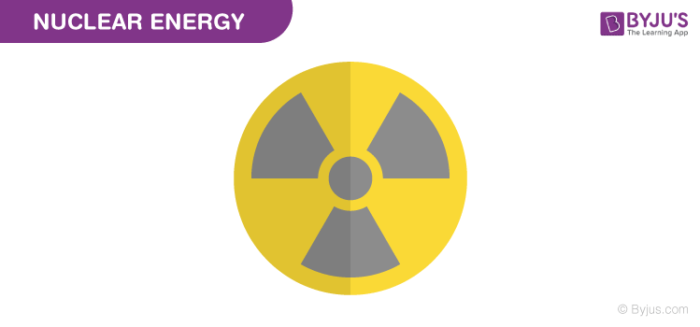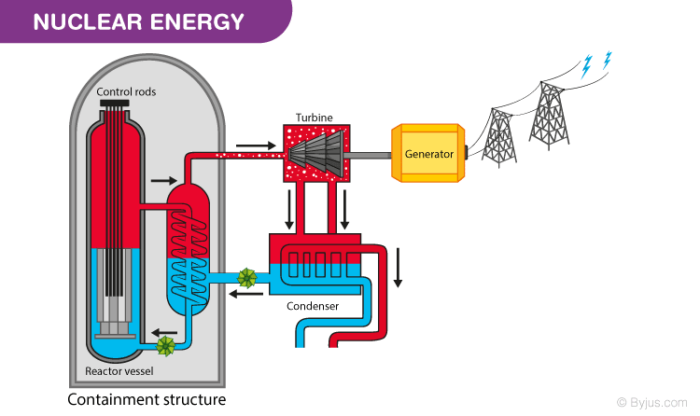What is Nuclear Energy?
Nuclear Energy is the energy in the core of an atom. Where an atom is a tiny particle that constitutes every matter in the universe. Normally, the mass of an atom is concentrated at the centre of the nucleus. Neutrons and Protons are the two subatomic particles that comprehend the nucleus. There is an exact massive amount of energy in bonds that bind atoms together.
Nuclear Energy is discharged by nuclear reactions either by fission or fusion. In nuclear fusion, atoms combine to form a larger atom. In nuclear fission, the division of atoms takes place to form smaller atoms by releasing energy. Nuclear power plants produce energy using nuclear fission. The Sun produces energy using the mechanism of nuclear fusion.

Nuclear Reactions
Nuclear reactions cause changes in the nucleus of atoms which in turn leads to changes in the atom itself. Nuclear reactions convert 1 element into a completely different element. Suppose if a nucleus interacts with any other particles and then separates without altering the characteristics of other nuclei then the process is called as nuclear scattering rather than specifying it as a nuclear reaction. This does not imply radioactive decay.
One of the most evident nuclear reactions is the nuclear fusion reaction that occurs in fissionable materials producing induced nuclear fission.

Nuclear Reactions – Types
- Inelastic scattering: This process takes place when a transfer of energy occurs. It occurs above threshold energy.i.e Et = ((A+1)/A)* ε1, where Et is called as the inelastic threshold energy and ε1 is the energy of the first excited state.
- Elastic Scattering: It occurs when there is energy transfer between a particle and intends nuclei. It is the most vital process for slowing down neutrons. In the case of an elastic scattering total kinetic energy of any system is conserved.
- Transfer Reactions: The absorption of a particle followed by discharge of 1 or 2 particles is referred as transfer reactions.
- Capture Reactions: When nuclei capture neutral or charged particles followed by discharge of ˠ-rays, it is termed as capture reactions. Radioactive nuclides are produced by neutron capture reactions.
Applications of Nuclear Energy
- Nuclear technology
- Nuclear medicine
- Nuclear Technology is used in Industries
- Agricultural uses of nuclear technology
- Environmental uses of nuclear technology
- Biological Experimentations
- Medical diagnosis and treatments
- Scientific Investigations
- Engineering Projects
- Neutron Activation Analysis
Frequently Asked Questions – FAQs
What is nuclear energy and its examples?
The energy is produced by a nuclear reaction, in particular by fission or fusion. Nuclear energy is a supply of energy produced by the energy emitted by a nuclear reaction. The electricity produced by a nuclear reactor, which is the primary power source used in Japan, is an example of nuclear technology.
What is nuclear energy in simple words?
Nuclear energy is the energy that is in an atom’s nucleus, or core. Atoms are small units of the universe that make up all matter, and energy is what binds together the nucleus. In an atom’s dense nucleus, there is an immense quantity of energy.
What are two types of nuclear energy?
For energy generation, there are two basic nuclear processes considered: fission and fusion. Fission is the energetic separation into two smaller atoms, or fission products, in massive atoms such as Uranium or Plutonium. You have to strike it with a neutron to break an atom.
What is nuclear used for?
Multiple industries, including consumer goods, food and agriculture, industry, medicine and science research, transport and water supplies and the atmosphere, have important uses for radioisotopes, nuclear power heat processing and non-stationary power reactors.
Does nuclear energy harm the environment?
As fuel, nuclear power plants use uranium. The uranium mining operation emits high levels of carbon dioxide into the atmosphere. When new nuclear power stations are built, carbon dioxide is also released into the atmosphere. Lastly, the transport of hazardous waste often produces pollution of carbon dioxide.
To learn more about the Nuclear Fuel Cycle and more, register with BYJU’S and download our app.

Comments